How To Change Brush Presets In Krita
Brush Tips¶
Auto Brush¶
The generic circle or square. These brush tips are generated past Krita through certain parameters.
Types¶
Get-go, there are 3 mask-types, with each the circle and square shape:
- Default
-
This is the ultimate generic blazon. The Fade parameter produces the below results. Of the three machine brushes, this is the fastest.

- Soft
-
This ane'southward fade is controlled by a curve!
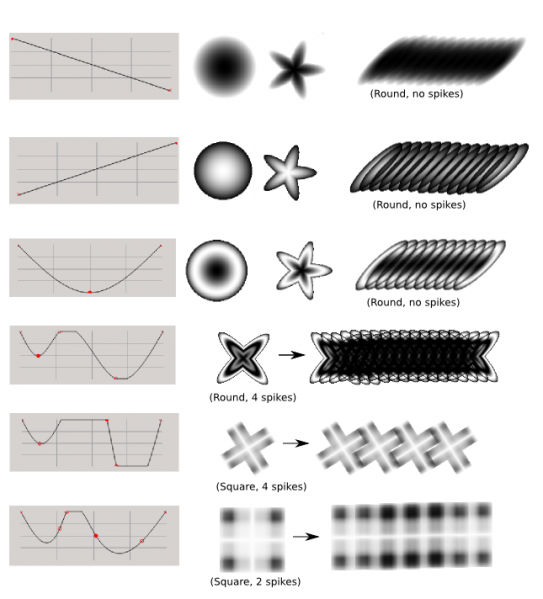
- Gaussian
-
This one uses the gaussian algorithm to determine the fade. Out of the 3 auto brushes, this is the slowest.
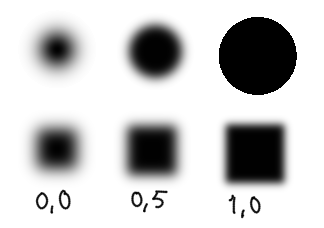
Parameters¶
- Diameter
-
The pixel size of the castor.
- Ratio
-
Whether the brush is elongated or not.

- Fade
-
this sets the softness of the brush. You can click the concatenation-symbol to lock and unlock these settings. Fade has a different effect per mask-type, and so don't exist alarmed if information technology looks strange, perchance y'all have the incorrect mask-type.
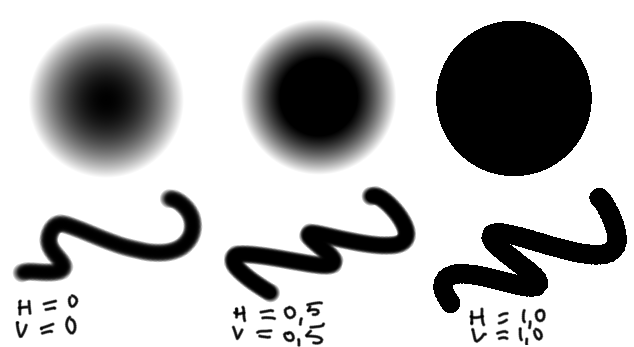
With fade locked.

With fade separately horizontal and vertical.
- Bending
-
This changes the bending a which the brush is at.

- Spikes
-
This gives the corporeality of tips related to the ratio.

- Density
-
This determines how much area the brush-covers over its size: Information technology makes information technology noisy. In the case beneath, the brush is set up with density 0%, 50% and 100% respectively.
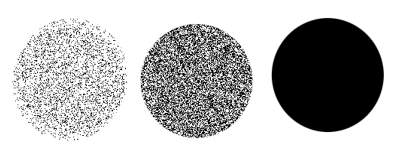
- Randomness
-
This changes the randomness of the density. In the case below, the brush is set with randomness 0%, 50% and 100% respectively.

- Spacing
-
This affects how far brushes are spaced autonomously. In the below picture, the three examples on the left are with spacing 0, 1 and 5.
- Auto (spacing)
-
Ticking this will set the brush-spacing to a different (quadratic) algorithm. The result is fine control over the spacing. In the below picture, the 3 examples on right are with auto spacing, 0, 1 and five respectively.

- Polish lines
-
This toggles the super-smooth anti-aliasing. In the below case, both strokes are drawn with a default brush with fade set up to 0. On the left without smooth lines, and the correct with. Very useful for inking brushes. This option is all-time used in combination with Car Spacing.
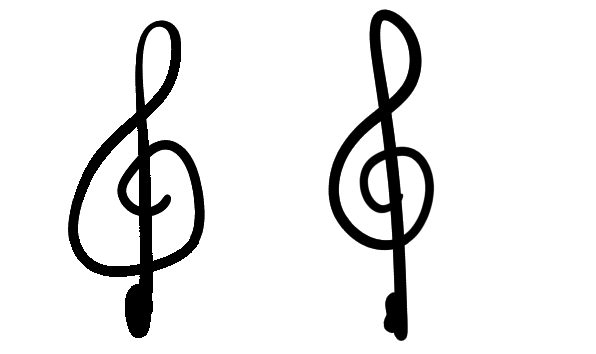
- Precision
-
This changes how polish the castor is rendered. The lower, the faster the brush, but the worse the rendering looks. You'd desire an inking brush to take a precision of 5 at all times, but a big filling brush for painting doesn't require such precision, and can be hands sped up by setting precision to one.
- Automobile (precision)
-
This allows you to gear up the precision linked to the size. The beginning value is the castor size at which precision is at last v, and the 2nd is the size-difference at which the precision will decrease.
For example: A castor with ''starting brush size'' 10 and ''delta'' 4, volition take…
-
precision 5 at size 10
-
precision 4 at size fourteen
-
precision 3 at size 18
-
precision 2 at size 22
-
precision one at sizes higher up 26.
-
Predefined Brushes¶

If you have used other applications like GIMP or Photoshop, you lot will take used this kind of castor. Krita is (mostly) compatible with the brush tip definitions files of these applications:
- abr
-
Gimp autobrush tip definitions.
- *.gbr
-
Gimp single bitmap brush tip. Can exist black and white or colored.
- *.gih
-
Gimp Image Hose brush tip: contains a series of brush tips that are painted randomly or in order after each other. Tin can be blackness and white or colored. Krita does not withal support all the parameters notwithstanding.
- abr
-
Photoshop brush tip collections. We back up many of the features of these brush files, though some advanced features are not supported nevertheless.
Note that the definition of ABR brushes has been reverse engineered since Adobe does not brand the specification public. We strongly recommend every Krita user to share brush tips in GBR and GIH format and more complex brushes as Krita presets.
All predefined brush tips are shown in one selector. There are four more options that influence the initial bitmap brush tip yous start painting with:
- Size
-
Scales the brush tip. 1.0 is the native size of the brush tip. This tin be fairly big! When painting with variable size (for instance governed by pressure), this is the base of operations for the calculations.
- Rotation
-
Initial rotation of the castor tip.
- Spacing
-
Distance between the brush tip impressions.
Brush Fashion¶
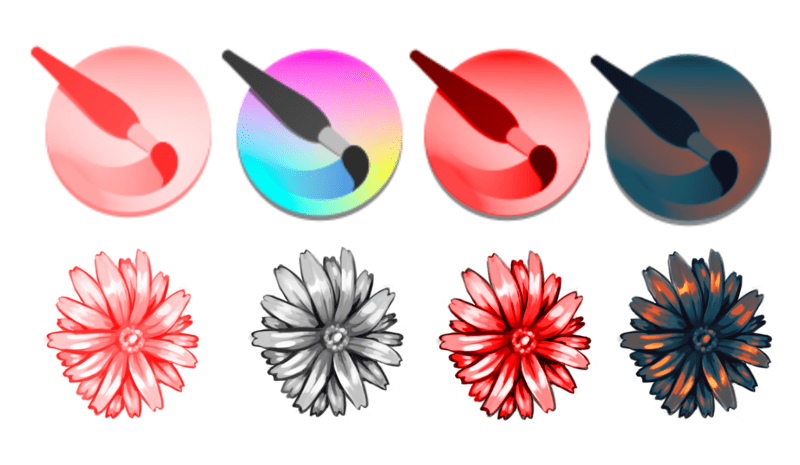
Unlike modes shown with different castor tips.¶
- Alpha Mask
-
For colored brushes, don't paint the actual colors, but make a grayscale castor tip that will be colored by your selected foreground/background color. Lighter areas volition be interpreted every bit more transparent.
- Color Prototype
-
Utilise the brush tip image exactly as it is. Especially useful for image stamps.
- Lightness Map
-
New in version iv.three: Combines the features of Alpha Mask and Prototype Stamp modes. Transparency is preserved as it is in Image Stamp mode, but colors or grayness tones in the brush are replaced past the foreground color. The Lightness values of the castor tip epitome (if thinking in HSL mode) are preserved, then night parts of the image are dark, and bright parts are bright. This allows image stamps where you can choose the color, but preserve highlights and shadows, and can even create an effect of thick paint in a brush stroke by simulating the highlights and shadows acquired past the texture of the pigment and brush stroke (sometimes called an "impasto" effect).
At that place are 3 sliders here, to control the exact feel of the electric current castor tip in Lightness or Gradient way:
- Neutral point
-
This is the lightness level that will exist the aforementioned as your electric current foreground color. Higher values than this will be lighter versions of the current foreground colour, and lower, darker versions of the electric current color.
- Brightness
-
Makes the tip as a whole brighter or darker.
- Contrast
-
Increase the contrast between night and calorie-free areas in the tip.
- Gradient Map
-
New in version iv.four: Use the lightness values of the brush tip image as a map to a gradient. Black maps to the left side of the gradient, and white to the correct side of the gradient. The gradient used is the currently selected gradient in the main window, so you can change the gradient quickly and easily while painting. This style allows prototype stamps with multiple colors that can be changed (great for flowers or other colorful vegetation), and can allow paint brushes that accept multiple colors. Image aligning sliders for Lightness Map mode tin can exist used for this manner as well. A tutorial for this style is here: Gradient Map Castor Tips .
Source: https://docs.krita.org/en/reference_manual/brushes/brush_settings/brush_tips.html
Posted by: duranhishentimed.blogspot.com

0 Response to "How To Change Brush Presets In Krita"
Post a Comment